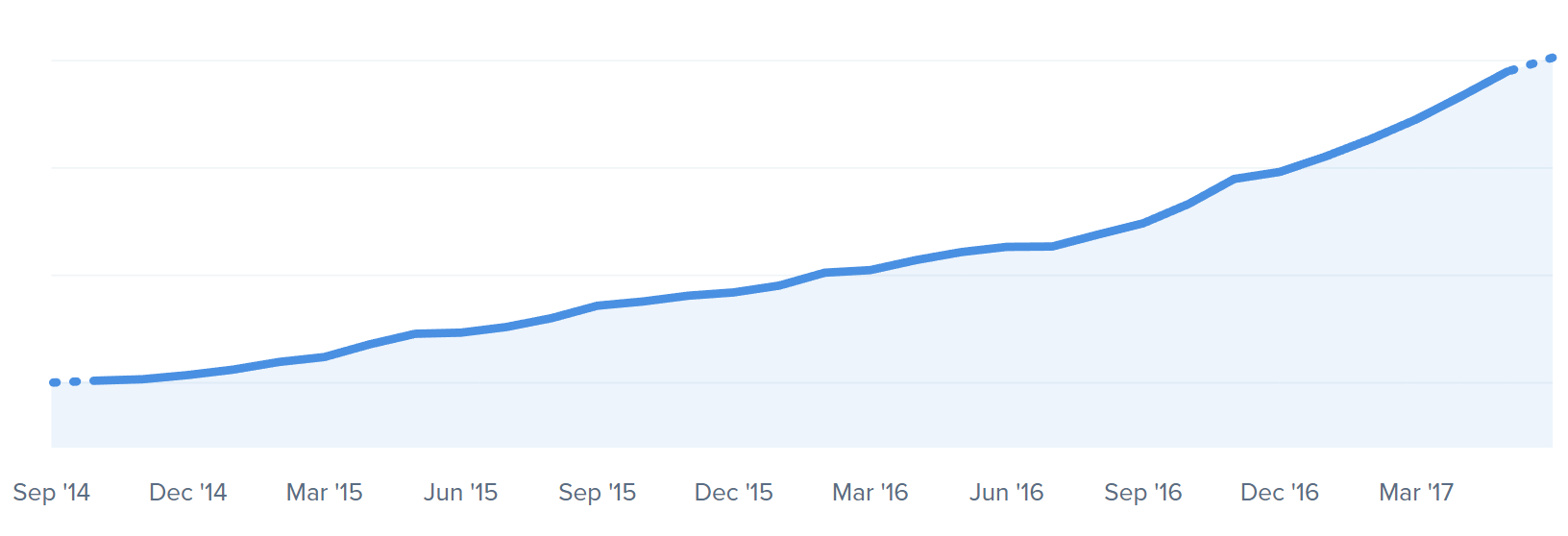Many of you may not know this but Kinsta is proud to call itself a bootstrapped company. This means we have never taken outside funds from venture capitalists or outside investors, unlike some of our competitors. We appreciate what VCs have to offer, and there are without a doubt, many world-class solutions and startups today that wouldn’t exist without their help. But there are also pros and cons to going down this route. So today we want to dive into eight benefits of not being a VC-funded company, and how you can still create a successful and profitable business. How? By focusing on providing real value for your customers and building a lean startup team.
- Bootstrapping is Not as Risky
- You Can More Easily Say No
- Loyalty and Priority is to Customers
- Bootstrapping Forces Fast Unconventional Thinking
- Single Focus on Making Money
- Retain More Control
- New Hires are Properly Evaluated
- Stronger If You Survive
1. Bootstrapping is Not as Risky
Bootstrapping is not as risky. Now, of course, this can be argued both ways. But we can all agree that the startup and VC world is ruthless, cutthroat, and highly competitive. Not many businesses succeed and so the choice of whether or not to take VC money is something that every owner should very carefully contemplate. Some of you are probably familiar with HBO’s Silicon Valley, and while it’s a comedy, Neil Patel put together a great post on 10 lessons digital marketers can learn from it. A lot of what they touch on is way over the top, but there is some wisdom that can be extracted from the show.

Simply put, if you choose to throw investors into the mix, this can magnify the risk, as they are expecting to see a high-return within a certain timetable. Whether this is from an exit, IPO, or acquisition. You need to be able to scale quickly and pivot when needed. We aren’t saying that all investments from venture capitalists are bad, but there can be a lot of pressure and problems associated with accepting outside funds. VCs give you money to see a better return on their investment, and that is typically the number one factor that drives them. They might care about your product or they might not. What they need is for the product to succeed. Here are just a few stats you should be aware of:
- According to some estimates, almost 90% of startups fail. That’s right only 1/10 companies make it.
- Ghosh estimates that between 70 and 75 percent of venture-backed startups don’t return the money investors put in – and of those, more than half return nothing.
- According to a study by CB Insights, just 22 percent achieved a sale or IPO, and 1 percent reached a value of $1 billion.
Many companies you have probably never heard of, such as Sprig, successfully raised funding, but couldn’t properly scale their business model and ended up going under. Or popular ones such as Jawbone, who was a pioneer in wearable devices, but is now not able to pay vendors after receiving $1 billion in VC funds. Ironically, even as of writing this blog post we received an email about the Filament product by ShareThis being discontinued (as seen below). Many of you have probably received similar emails about companies and products which one day are doing fine, and the next they are simply gone. Remember, that just because a company received funding, it doesn’t always mean they are successful or will survive.

The flip side of this can also be argued in which bootstrapping could be the riskier move as you are staking your entire company on being able to scale while self-funding. In most cases, taking VC money means you are spreading the risk across multiple VCs and you are not “as” responsible if the business fails. Dan Norris, a successful entrepreneur who sold off WP Curve to GoDaddy in 2016, also brings up a great counter-argument in which he states:
For some businesses and some situations, you need outside money. The fact that someone wants to put money into your business and own some of it, is a good sign. It means you are creating something valuable. Maybe you have a vision that stretches more than 5 minutes into the future and you have been able to sell that vision to someone else. This is not a bad thing.
But remember that no matter how you look at it, when you take money, there is always an immediate expectation on the other end and the clock starts ticking. You must scale fast or fail. There is something to be said for scaling at your own pace while bootstrapping, as the risk is on you and you alone.
2. You Can More Easily Say No
We all know that with any business, there are good clients and there are bad clients. You have probably all had a good laugh from the Clients From Hell site at one time or another. And while this is meant to be a parody, it is closer to reality than many think. There is always that one customer that will take up 90% of your time, while you never hear from the rest. In these situations, it can be wise for your business to simply say no. And in some cases part ways. When you are bootstrapping you can more easily select your clients, and say no whenever it makes sense to help your team and mission going forward.
Saying no is NOT always bad customer service. — Peter House (src: Art of Saying No)

And of course, when you are bootstrapping, time management and delegation is much more important. You have to ensure your support team is not devoting all of their time to one or two clients, but rather providing high-quality support across the board. If you are VC-funded, a lot of times you won’t simply drop or say no to potential clients based on the notion of how they might affect the company, it is all about increasing the user base.
Here are some great tips on how to say no to a client without making them angry.
3. Loyalty and Priority is to Customers
When bootstrapping a company, all of your income is from your customers, and so they instantly become your number one priority, not investors. This is a win for both the customers and the company. We always try to go the extra mile for customers here at Kinsta, and while there are things we don’t support, such as development work, we will always try to help. A lot of our growth over the years has been from word of mouth and customer referrals. We love our customers, have formed great relationships with them, and we would not be here without them!
In 2018, three of Kinsta’s main competitors have raised their prices dramatically while ours have stayed the same. Since we don’t have VCs telling us what to do in the background we can take the time and properly scale, keeping quality and support intact.
4. Bootstrapping Forces Fast Unconventional Thinking
Not having funds to throw at problems forces you to come up with cost-effective, creative ways to solve them. You have to think outside of the box. Bootstrapping companies don’t always have a 15k budget per month to spend on Google AdWords. This forces you to look for less conventional answers to common problems. Over time, this will make you a better problem-solver and always have a focus on your cost per acquisition (CPA) and the average lifetime value of a customer.

Instead of PPC, which can bleed you dry if not done correctly, perhaps you invest time into content marketing or social media to promote your product or service. Or use forms of PPC with cheaper CPC, such as Facebook and Quora ads. Launching an affiliate program is another great way to leverage your current customer base to essentially help market your company for you. Here is a great article on 21 marketing ideas for those with small budgets. In 2017 there are countless methods marketers are using to get the word out there about their brands.
Bootstrapping requires you to be innovative. Most inventions come from the need, specifically the needs of individuals. And this is where things become interesting. When all of your savings and the mortgage you took on your house so that you can launch your company is on the line, the drive and pressure will force you to either innovate or fail. There are no other choices.
Essentially, you must be good fast. Product development, marketing, implementing customer’s feature requests, etc. have to become efficient quickly. In our opinion, this is a benefit, because your team has to stay on its feet and constantly be figuring out new ways to reach customers. And in the end, your team will be much stronger and smarter because of it.
Would you rather have a team that throws 15k at AdWords, or a team that can bring in the same number of customers by using more cost-effective and a wider array of acquisition channels?
5. Single Focus on Making Money
When bootstrapping a company, the primary and single focus is on making money, rather than spending it. A lot of VC-funded companies are built or structured around growing their user base or number of installs as fast as humanly possible. Even if they aren’t paying customers, as they are simply looking to get acquired or for a quick exit. There is definitely value in users, but if your plan fails, these users could be worthless overnight.

Imzy, a popular Reddit alternative with tens of thousands of users, just recently announced that they are shutting down. The company’s co-founder Dan McComas stated:
Some of you have been here since our launch into beta and some are brand new. We’ve loved getting to know all of you and seeing you build communities and make new friends. Unfortunately, we were not able to find our place in the market. We still feel that the internet deserves better and hope that we see more teams take on this challenge in the future.
If you structure your company from the beginning with an emphasis on making money, this can be a much safer route. Focusing on simply growing the user base can sometimes negate you from the really important issue, such as your business needs to make money to scale. Along with this comes a better understanding of money management, accounting, and what your expenses are. When bootstrapping, every penny counts as they say. And this is not always a bad thing.
6. Retain More Control
One of the most obvious benefits to not being a VC-funded company is of course that you retain more control. Chances are that one of the reasons you’re starting a business in the first place is to have some autonomy. If you have a great idea and can execute it, why give up part of it to outside investors who probably don’t love your product/service as much as you do? The sooner you sell equity, the more it will cost you, as you suddenly lose leverage for later down the road, as well as dilution.
Sadly, a good example of this is Lane Becker, co-founder of Get Satisfaction. They ended up in a fire sale, and with a $50 million dollar valuation, he didn’t get a penny. He states that the main reason for this is that they lost control of their business to venture capitalists, as well as raising funds too early on.
I appreciate the sentiment, but don't congratulate me on the GS acquisition. The founders were washed out of the deal. We got nothing.
— Lane Becker (@monstro) April 8, 2015
Another example is Aaron Levie, the CEO of Box. When they IPO’d it was estimated that he only owned around 5.7% of the company. Of course, this can be argued both ways, as investors might be able to get you to where you need to go faster, but you should do everything you can do build your company with limited funds. If one day you are to the point where you are preparing for an acquisition, you will be happy you did.
Another strategy is to give a small amount of equity to members of your team. This can be a great way to motivate employees and make sure they are with you for the long haul. And generally, this involves giving up a lot less equity than it would to investors.
7. New Hires are Properly Evaluated
New hires are obviously very important, whether you are a bootstrapped company or VC-funded. However, when you have limited funds, every new individual hire becomes that much more crucial to your success. If a VC hands you 10 million dollars, most likely the first thing you will do is go out and quickly hire the rest of your team to begin scaling.
A benefit to bootstrapping is that this is entire process is done at a much slower pace, only hiring new employees as the company grows and brings in more revenue. The owner can then more easily assess each individual employee, their skills, and ensure they are a perfect fit for the company moving forward.
8. Stronger If You Survive
If you survive bootstrapping, you will have a strong, lean, efficient, and customer-focused company moving forward. You know what works and what doesn’t, where to focus your marketing, development, and support efforts, as well as which channels are most profitable in terms of user acquisition.
Kinsta has been bootstrapped from the very beginning and we’ve seen a continuous customer and revenue growth since launch. Over the past 12 months, our client base has grown by over 308%. We try to stay as open and transparent as possible, so here is our MRR (monthly recurring revenue) graph below, pulled directly from Baremetrics. We are now generating 4x what we did in 2015.

We love how Nathan Barry, the founder of ConvertKit, refers to his company as “proud to be independent and customer-funded.” This is very much the same philosophy we hold. We wouldn’t be here without our loyal customers.
Summary
As you can see there is a lot to contemplate when it comes time to decide on whether or not to go the VC route. We are proud here at Kinsta to be a bootstrapped company and we feel that we have a stronger team because of it. We are growing at a very rapid pace and have been profitable since the beginning. We’re not against VC funding and if it’s ever needed we’ll try to find the right partners, but for now, we firmly believe bootstrapping is better for us and the customers. It is possible to create a successful business without VC money, so don’t let anyone pressure you. Bootstrapping could take you longer to get to where you want to be, but it might just be the best decision you ever make.
What are your thoughts on bootstrapping? If you have a positive or negative experience, share it down below in the comments.


